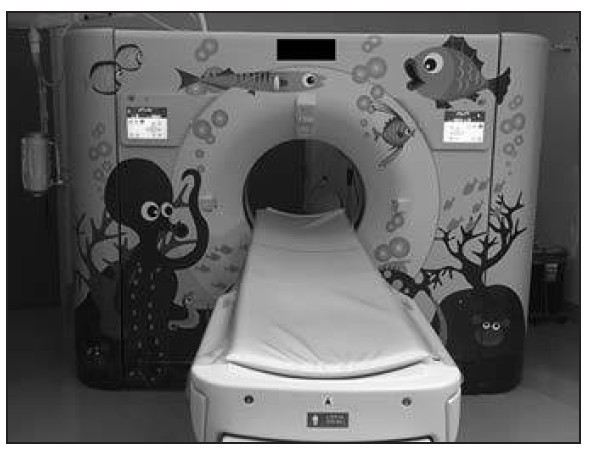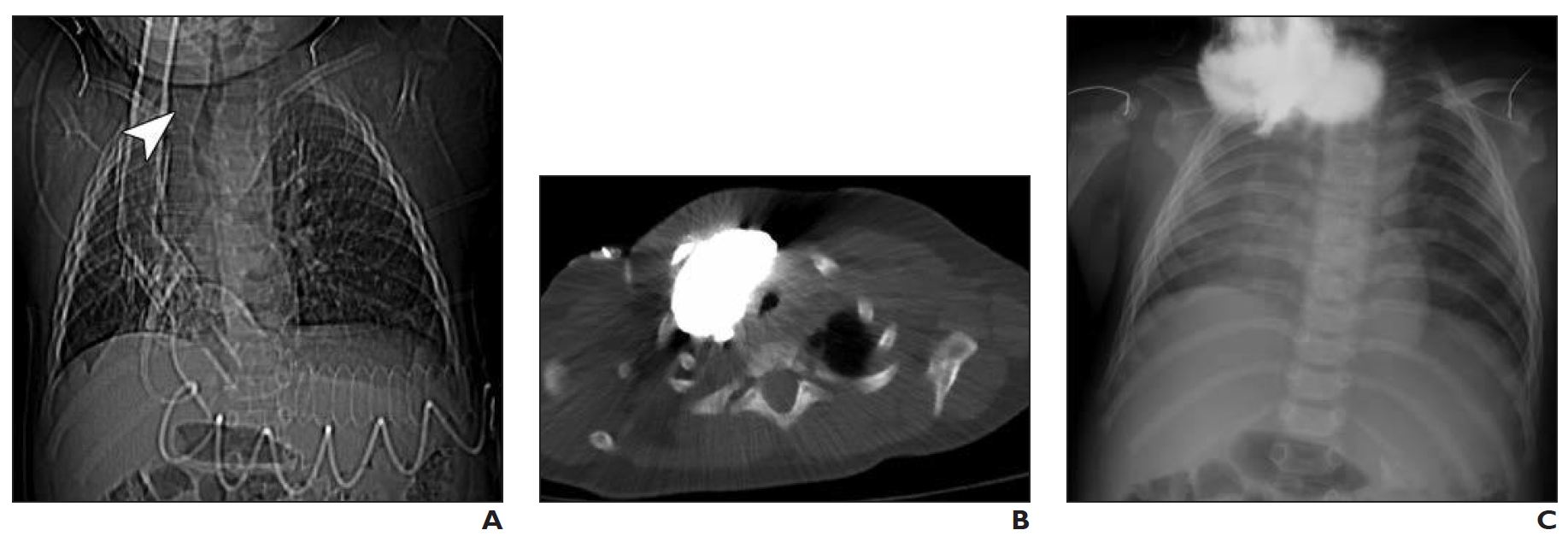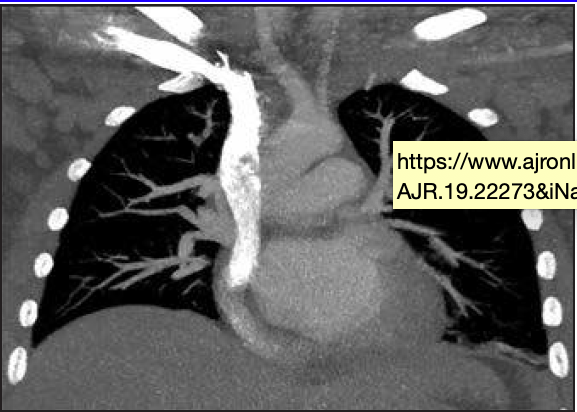10 Tips You Should Know About Pediatric Body CTA
Understanding the underlying principles and details of CTA can help optimize dose and improve diagnostic quality for pediatric patients.
Imaging pediatric patients is always a delicate matter, and it is largely guided by the Image Wisely and Image Gently principles. These guidelines are particularly important with CT angiography (CTA) in children due to the high sedation or general anesthesia risks or the emergent nature of the imaging.
To help radiologists maximize the capabilities of CTA studies while controlling radiation dose for the smallest patients, a multi-institutional team recently published an article in the American Journal of Roentgenology, outlining 10 general principles that can serve as guideposts.
“The ultimate goal of pediatric CTA optimization is to minimize radiation exposure while maintaining diagnostic image quality for accurate diagnosis,” said lead study author Tushar Chandra, M.D., a pediatric radiologist with Nemours Children’s Health System in Florida. “Therefore, basic CT principles…should be strictly followed at this age.”
Their recommendations are summarized here, and further details can be found in their study.
Take-Away 1: Know Your Patient, Your Scanner, and the Clinical Context
Being familiar with a scanner is critical. Have at least a basic understand of the equipment’s geometry to maximize image quality and diagnostic usefulness while minimizing radiation exposure. And, remember that different vendors use varying nomenclature for their scanner. The American Association of Physicists in Medicine website is a good resources to see what the vendor of your scanner uses, the team suggested.
Be aware that dual-source CT scanners with their two pairs of X-ray sources provide dose savings and improved temporal resolution. In addition, each tube can be operated at a different tube potential, allowing for material decomposition. Dual-source systems also have much higher non-overlapping pitch coverage that can fill in missing data. This can be particularly important with pediatric patients because shorter scan times can help avoid more sedation and minimize motion artifacts.
Child-friendly theme in CT examination room can ease anxiety of children. Courtesy: American Journal of Roentgenology

When possible, the team recommended, perform scans in a comfortable, child-friendly atmosphere. Studies have shown that using a miniature scanner before the actual scan can reduce anxiety by 16 percent in children under 18 months and by 28 percent in children under age 4.
Take-Away 2: Timing Matters
The timing of a scan can be tricky as newer and faster scanners have minimized the window for capturing imaging during optimum contrast enhancement. Remember that opacification occurs in this order: pulmonary arteries, coronary arteries, the aorta, and distal systemic arteries. And, the time for contrast material to opacify is dependent upon a patient’s cardiac output and distance from the IV site.
When selecting a scan timing method, be aware of the advantages and disadvantages, the team advised. The timing bolus method tests the adequacy of the contrast medium pathway, and it approximates the relationship between the bolus geometry of the test bolus and the main bolus. But, it requires two contrast injections, taking more time and more contrast medium volume. The bolus trigger method is more time efficient and uses a single injection. However, it relies on empirically choosing a threshold and a delay time which might not yield the best results. It is also prone to streak artifacts and other issues.
Take-Away 3: IV Access and Contrast Material Risks
For optimal contrast enhancement, the team said, be sure the venous access site and catheter size match the rate of contrast injection for the study being conducted. Peripheral veins are the preferred IV access site. Avoid injections into the dorsum of the hand – in newborns and infants, a foot vein is a good alternative. If a hand injection is necessary in a pediatric patient, diagnostic quality images are possible, the team explained, if it is combined with the bolus-tracking method.
The American College of Radiology guidelines outline a safe process for power injection of contrast medium through some central catheters if peripheral access is difficult. A CT scout image or recent radiograph must confirm the location of the catheter tip which should, then, be tested for venous backflow. Consider alternative routes if there is any abnormal resistance or discomfort, and pay close attention if the catheter tip is in the heart because pulmonary arteries can opacify immediately.
7-month-old boy with contrast extravasation after power injection of central venous catheter (CVC). Study was requested to assess for scimitar syndrome. A. Scout view of chest shows tip of CVC (arrowhead) projecting over central right internal jugular vein or peripheral right innominate vein, which is not central enough for power injection. B and C, Axial CT image (B) and subsequent chest radiograph (C) show extensive contrast extravasation into soft tissues of right neck, right supraclavicular region, and right upper chest. Courtesy: American Journal of Roentgenology

In cases where peripheral IV access is not possible, intraosseous contrast medium administration is acceptable for rates up to 4 mL/s.
Take-Away 4: The Importance of Saline
Saline chasers, which are typically injected immediately after IV contrast material using a dual-head injector, result in faster contrast distribution, increased peak aortic enhancement, and decreased venous artifacts. Its use results in lower volume of contrast material used without decreasing vascular contrast density. With pediatric patients, a saline chaser, which is typically 10-30 mL infused at a 6 mL/s rate, can preserve injection volume and duration.
CT angiogram of 15-year-old girl with clinical concern for pulmonary embolism in whom saline chaser was not used shows high-density contrast material in superior vena cava. Courtesy: American Journal of Roentgenology

Take-Away 5: Gantry Rotation Time and Pitch
Many scanners have a streamlined, one-button-push protocol selection process, but be sure you understand the scan acquisition parameters, radiation dose, and study quality to tailor the exam to the individual patient and the clinical context. Keep gantry rotation time low to avoid motion artifacts, but be aware that speeding the scan up can mitigate or eliminate motion in older pediatric patients who have abnormally rapid breathing.
For pediatric patients, the team advised, use the highest pitch possible that still allows for diagnostic image quality. This is usually between 1.0 and 1.5 for single-source systems and 3.0 to 3.4 for dual-source scanners.
Take-Away 6: Kilovoltage Setting
Low tube energy is a preferred way to reduce radiation exposure with CTA. For most children, particularly in the first decade of life, 80 kVp is most often used with thoracic and abdominal CTA. More specifically, existing research suggests 70 kVp for thoracic CTA in children from newborns to age 5. But, for older children, 100 kVp can be used. Some more recent studies have suggested that, if the interpreting radiologist is willing to accept higher noise for increased vascular contrast, 70 kVp can be used, the team said.
Some vendors provide automated tube kilovoltage selection technology that can be tailored to the patient to ensure the lowest possible kilovoltage setting while protecting diagnostic image quality. Be careful when using this feature when the CT table is positioned close to the X-ray source, though, because patients can appear magnified on the scout view, resulting in higher tube voltage, higher tube currents, or both.
Take-Away 7: Tube Current
Reducing tube current by half reduces radiation dose exposure by half, the team said, but it can also lead to noise in gathered images. This can be particularly problematic in children because they lack the visceral fat to counteract the impact of increased noise. Small things, such as moving the patient’s arms out of the field-of-view with a chest or abdominal CTA or removing any metal-containing support apparatus can, can significantly reduce tube current.
Some vendors offer automated tube current modulation that takes a patient’s size, shape, and geometry into consideration. This feature can maintain constant image noise and can offer a 40-percent to 50-percent radiation dose reduction without compromising diagnostic quality.
Take-Away 8: Scan Direction
Typically, after a scout radiography, CT acquisition is usually performed craniocaudally in the direction of contrast propagation. According to existing research, the one exception to this rule is craniocaudal scanning for pulmonary CTA for pulmonary embolism detection. In those cases, the team said, scan the lower lobes first. Not only do pulmonary emboli most frequently involve the lower lobes, but scanning this region first reduces the chance of artifacts from respiratory motion. Doing so also reduces any artifact from dense contrast material within the superior vena cava.
Take-Away 9: Post-processing
While filtered back projection has long been considered the standard CT reconstruction method, it has limitations, the team said. Iterative reconstruction techniques are an alternative with advantages, such as noise reduction and dose savings, that is offered by all CT vendors. In fact, one existing study reported a 34-percent drop in noise.
In addition, the team explained, model-based iterative reconstruction demonstrates better performance than hybrid techniques, but the trade-off is longer processing time. Artificial intelligence algorithms that can accelerate the reconstruction process and further reduce dose are also under development.
Take-Away 10: Dual- or Split-Bolus Technique
In situations where imaging of arteries, veins, solid visceral organs, or the bowel wall is necessary, multiple passes are traditionally required. However, it is possible to capture these images in a single pass. The technique, which involves a weight-stratified dual-bolus multi-compartmental IV contrast injection regimen, splits the contrast material into two portions, allowing the entire body to be scanned in a single acquisition.
Not only does the technique reduce exposure by eliminating the need for multiple acquisitions, but it also allows the concomitant opacification of systemic arteries, pulmonary arteries, portal veins, and solid organs in one pass. It is a strategy that can be adapted based on the scanner, clinical context, or patient age and weight, and it has already been applied to assessments for pancreatic lesions and abdominal trauma, as well as renal donor evaluation.
While these guidelines can help you side-step unnecessary radiation with patients, foregoing CTA whenever possible is still preferable, the team said.
“Avoiding unnecessary CTA investigations or possibly relying on non-ionizing radiation modalities, such as duplex ultrasound or MR angiography, if feasible, would be the best radiation protection measure,” they said.
The Reading Room Podcast: Emerging Trends in the Radiology Workforce
February 11th 2022Richard Duszak, MD, and Mina Makary, MD, discuss a number of issues, ranging from demographic trends and NPRPs to physician burnout and medical student recruitment, that figure to impact the radiology workforce now and in the near future.
Meta-Analysis Shows Merits of AI with CTA Detection of Coronary Artery Stenosis and Calcified Plaque
April 16th 2025Artificial intelligence demonstrated higher AUC, sensitivity, and specificity than radiologists for detecting coronary artery stenosis > 50 percent on computed tomography angiography (CTA), according to a new 17-study meta-analysis.
Could Lymph Node Distribution Patterns on CT Improve Staging for Colon Cancer?
April 11th 2025For patients with microsatellite instability-high colon cancer, distribution-based clinical lymph node staging (dCN) with computed tomography (CT) offered nearly double the accuracy rate of clinical lymph node staging in a recent study.